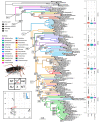Chromosome-Aware Phylogenomics of Assassin Bugs (Hemiptera: Reduvioidea) Elucidates Ancient Gene Conflict
- PMID: 37494292
- PMCID: PMC10411492
- DOI: 10.1093/molbev/msad168
Chromosome-Aware Phylogenomics of Assassin Bugs (Hemiptera: Reduvioidea) Elucidates Ancient Gene Conflict
Abstract
Though the phylogenetic signal of loci on sex chromosomes can differ from those on autosomes, chromosomal-level genome assemblies for nonvertebrates are still relatively scarce and conservation of chromosomal gene content across deep phylogenetic scales has therefore remained largely unexplored. We here assemble a uniquely large and diverse set of samples (17 anchored hybrid enrichment, 24 RNA-seq, and 70 whole-genome sequencing samples of variable depth) for the medically important assassin bugs (Reduvioidea). We assess the performance of genes based on multiple features (e.g., nucleotide vs. amino acid, nuclear vs. mitochondrial, and autosomal vs. X chromosomal) and employ different methods (concatenation and coalescence analyses) to reconstruct the unresolved phylogeny of this diverse (∼7,000 spp.) and old (>180 Ma) group. Our results show that genes on the X chromosome are more likely to have discordant phylogenies than those on autosomes. We find that the X chromosome conflict is driven by high gene substitution rates that impact the accuracy of phylogenetic inference. However, gene tree clustering showed strong conflict even after discounting variable third codon positions. Alternative topologies were not particularly enriched for sex chromosome loci, but spread across the genome. We conclude that binning genes to autosomal or sex chromosomes may result in a more accurate picture of the complex evolutionary history of a clade.
Keywords: X chromosome; gene conflict; gene content; phylogenomics; sex chromosome.
© The Author(s) 2023. Published by Oxford University Press on behalf of Society for Molecular Biology and Evolution.
Figures




Similar articles
-
Evolutionary history of assassin bugs (insecta: hemiptera: Reduviidae): insights from divergence dating and ancestral state reconstruction.PLoS One. 2012;7(9):e45523. doi: 10.1371/journal.pone.0045523. Epub 2012 Sep 28. PLoS One. 2012. PMID: 23029072 Free PMC article.
-
The architecture and complete sequence of mitochondrial genome of an assassin bug Agriosphodrus dohrni (Hemiptera: Reduviidae).Int J Biol Sci. 2011;7(6):792-804. doi: 10.7150/ijbs.7.792. Epub 2011 Jul 1. Int J Biol Sci. 2011. PMID: 21750648 Free PMC article.
-
The Aphid X Chromosome Is a Dangerous Place for Functionally Important Genes: Diverse Evolution of Hemipteran Genomes Based on Chromosome-Level Assemblies.Mol Biol Evol. 2020 Aug 1;37(8):2357-2368. doi: 10.1093/molbev/msaa095. Mol Biol Evol. 2020. PMID: 32289166 Free PMC article.
-
Evolution of gene function on the X chromosome versus the autosomes.Genome Dyn. 2007;3:101-118. doi: 10.1159/000107606. Genome Dyn. 2007. PMID: 18753787 Review.
-
Deep reticulation: the long legacy of hybridization in vascular plant evolution.Plant J. 2023 May;114(4):743-766. doi: 10.1111/tpj.16142. Epub 2023 Apr 21. Plant J. 2023. PMID: 36775995 Review.
References
-
- Altschul SF, Gish W, Miller W, Myers EW, Lipman DJ. 1990. Basic local alignment search tool. J Mol Biol. 215:403–410. - PubMed
-
- Arcila D, Ortí G, Vari R, Armbruster JW, Stiassny MLJ, Ko KD, Sabaj MH, Lundberg J, Revell LJ, Betancur-R R. 2017. Genome-wide interrogation advances resolution of recalcitrant groups in the tree of life. Nat Ecol Evol. 1:20. - PubMed
-
- Ballesteros JA, Hormiga G. 2016. A new orthology assessment method for phylogenomic data: unrooted phylogenetic orthology. Mol Biol Evol. 33:2481. - PubMed
-
- Bandi V, Gutwin C.. 2022. Interactive exploration of genomic conservation. [Last accessed 2020 Sep 29]. Available from: https://openreview.net/pdf?id=7-C5VJWbnI
Publication types
MeSH terms
LinkOut - more resources
Full Text Sources
Miscellaneous

